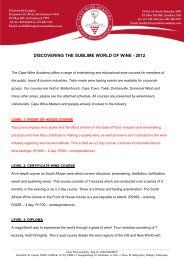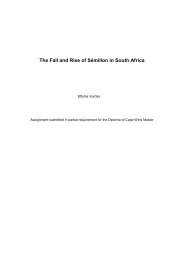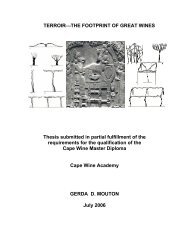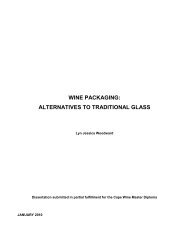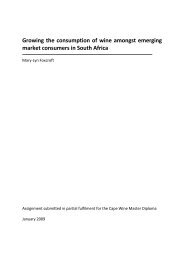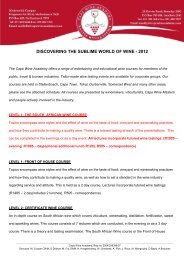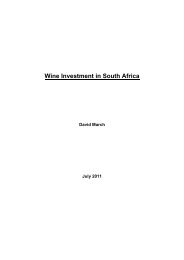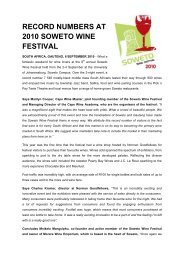micro-oxygenation in contemporary winemaking - Cape Wine ...
micro-oxygenation in contemporary winemaking - Cape Wine ...
micro-oxygenation in contemporary winemaking - Cape Wine ...
Create successful ePaper yourself
Turn your PDF publications into a flip-book with our unique Google optimized e-Paper software.
Micro-<strong>oxygenation</strong> <strong>in</strong> Contemporary W<strong>in</strong>emak<strong>in</strong>gas sherry and port. Lastly, there is a rapidly grow<strong>in</strong>g literature on the anti-oxidant role ofphenolic compounds and their potential health benefits, but aga<strong>in</strong> this will be consideredonly very briefly <strong>in</strong> relation to the potential impact of <strong>micro</strong>-<strong>oxygenation</strong> on w<strong>in</strong>e anti-oxidantcapacity.1.2 CONTRIBUTION OF THE REPORTThe purpose of this review is to provide an up-to-date description and synopsis of <strong>micro</strong><strong>oxygenation</strong>.There are a number of excellent and relatively recent reviews on w<strong>in</strong>ephenolic chemistry (Monagas et al., 2005; Fulcrand et al., 2006; Ribéreau-Gayon et al.,2006c; Parker et al., 2007) and the role of oxygen <strong>in</strong> w<strong>in</strong>emak<strong>in</strong>g (du Toit et al., 2006b;Danilewicz, 2007; Li et al., 2008), but the <strong>in</strong>tended contribution of this report is to presentthis somewhat technical material for a practitioner, rather than an academic audience.Another key objective of the report is to summarise the latest available scientific evidenceon the benefits and risks of <strong>micro</strong>-<strong>oxygenation</strong>. Although there are a number of generalreviews on <strong>micro</strong>-<strong>oxygenation</strong> (Parish et al., 2000; Zoeckle<strong>in</strong> et al., 2002; Blackburn, 2004;Pour-Nikfardjam and Creasy, 2004; Goode, 2005), none of these are very recent and fewprobe beyond the broad assertions of the <strong>micro</strong>-<strong>oxygenation</strong> <strong>in</strong>dustry. Although a numberof more rigorous studies of <strong>micro</strong>-<strong>oxygenation</strong> have been published <strong>in</strong> the last few years(del Carmen-Llaudy et al., 2006; Cano-López et al., 2006; du Toit et al., 2006a; Pérez-Magariño et al., 2007), a systematic review of this evidence has not yet been produced.1.3 OUTLINE OF THE REPORTThis report is broadly divided <strong>in</strong>to four ma<strong>in</strong> parts. Part I (Chapters 1 – 3) outl<strong>in</strong>es thethemes to be explored <strong>in</strong> this report and <strong>in</strong>troduces the <strong>micro</strong>-<strong>oxygenation</strong> technique byprovid<strong>in</strong>g a def<strong>in</strong>ition and brief history. Part II (Chapters 4 – 5) describes the commercialclaims and practical application of <strong>micro</strong>-<strong>oxygenation</strong>. Part III of the report (Chapters 6 – 7 )reviews the available scientific evidence concern<strong>in</strong>g the relevant chemical reactions as wellas the proven advantages and disadvantages of <strong>micro</strong>-<strong>oxygenation</strong>. F<strong>in</strong>ally, Part IVprovides some general conclusions and recommendations.4



